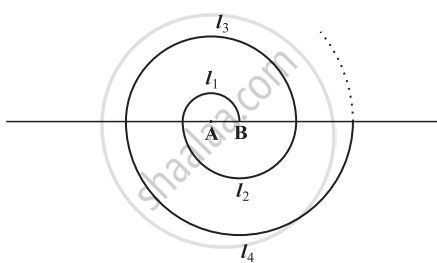Advertisements
Advertisements
प्रश्न
If the sum of first p terms of an A.P. is equal to the sum of first q terms then show that the sum of its first (p + q) terms is zero. (p ≠ q)
उत्तर
Given that `S_p=S_n`
We know,
`S_n = n/2[2a + (n - 1)d]`
Let a be the first term of the AP and d be the common difference
`p/2(2a+(p-1)d)=q/2(2a+(q-1)d)`
`p(2a+(p-1)d)=q(2a+(q-1)d)`
`2ap+(p-1)dp=2aq+(q-1)dq`
`2ap-2aq+(p-1)dp-(q-1)dq=0`
`2a(p-q)+d(p^2-p-q^2+q)=0`
`2a(p-q)+d[p^2-q^2-1(p-q)]=0`
`2a(p-q)+d[(p+q)(p-q)-1(p-q)]=0`
`2a(p-q)+d(p-q)[p+q-1]=0`
p ≠ q
p - q ≠ 0
Dividing throughout by (p - q),since p ≠ q.
`2a+(p+q-1)d=0` ... (i)
Using eq (i)
`S_(p+q)=(p+q)/2(2a+(p+q-1)d)`
`S_(p+q)=(p+q)/2xx0`
`S_(p+q)=0`
Hence, the sum of its first (p + q) terms is zero.
APPEARS IN
संबंधित प्रश्न
How many terms of the A.P. 27, 24, 21, .... should be taken so that their sum is zero?
If Sn denotes the sum of first n terms of an A.P., prove that S30 = 3[S20 − S10]
How many terms of the series 54, 51, 48, …. be taken so that their sum is 513 ? Explain the double answer
A spiral is made up of successive semicircles, with centres alternately at A and B, starting with centre at A of radii 0.5, 1.0 cm, 1.5 cm, 2.0 cm, .... as shown in figure. What is the total length of such a spiral made up of thirteen consecutive semicircles? (Take `pi = 22/7`)

[Hint: Length of successive semicircles is l1, l2, l3, l4, ... with centres at A, B, A, B, ... respectively.]
Find the sum of all integers between 84 and 719, which are multiples of 5.
Find the sum 3 + 11 + 19 + ... + 803
Determine the A.P. Whose 3rd term is 16 and the 7th term exceeds the 5th term by 12.
Find an AP whose 4th term is 9 and the sum of its 6th and 13th terms is 40.
Find the sum of all multiples of 9 lying between 300 and 700.
Choose the correct alternative answer for the following question .
What is the sum of the first 30 natural numbers ?
In an A.P. the 10th term is 46 sum of the 5th and 7th term is 52. Find the A.P.
Find the sum: 1 + 3 + 5 + 7 + ... + 199 .
Write 5th term from the end of the A.P. 3, 5, 7, 9, ..., 201.
A manufacturer of TV sets produces 600 units in the third year and 700 units in the 7th year. Assuming that the production increases uniformly by a fixed number every year, find:
- the production in the first year.
- the production in the 10th year.
- the total production in 7 years.
Q.3
Q.4
If the second term and the fourth term of an A.P. are 12 and 20 respectively, then find the sum of first 25 terms:
Find the sum of first 1000 positive integers.
Activity :- Let 1 + 2 + 3 + ........ + 1000
Using formula for the sum of first n terms of an A.P.,
Sn = `square`
S1000 = `square/2 (1 + 1000)`
= 500 × 1001
= `square`
Therefore, Sum of the first 1000 positive integer is `square`
If ₹ 3900 will have to be repaid in 12 monthly instalments such that each instalment being more than the preceding one by ₹ 10, then find the amount of the first and last instalment
The sum of all two digit odd numbers is ______.
